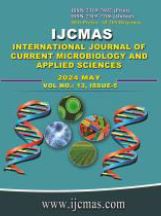


 National Academy of Agricultural Sciences (NAAS)
National Academy of Agricultural Sciences (NAAS)

|
PRINT ISSN : 2319-7692
Online ISSN : 2319-7706 Issues : 12 per year Publisher : Excellent Publishers Email : editorijcmas@gmail.com / submit@ijcmas.com Editor-in-chief: Dr.M.Prakash Index Copernicus ICV 2018: 95.39 NAAS RATING 2020: 5.38 |
A field experiments were conducted during the kharif (wet) season of 2020 and 2021 at farmers field of lower Dzongu North Sikkim, India with rice variety abhishek a high yield variety developed from CRRI Cuttack for the study of weed dynamics and rice productivity under various tillage practices in North East India. From the experimental findings it revealed that rice field was infested with three categories of weeds viz. grassy, broadleaved and sedges were predominant throughout the cropping period. Results revealed that the amongst the tillage practices, minimum population of all weed flora (grasses, sedges and broadleaved) was recorded with no till at 30 DAP. This leads to about 16.9%, 11.6% and 23.1% reduction in grasses, sedges and broadleaved weeds over the conventional practices, respectively. However, at 60 DAP reverse scenario of weed dynamics has been observed in grasses and broad leaved. Similar trend was observed in case of dry weight. Grain yield was also significantly influenced by different tillage and organic nitrogen sources and the highest yield was recorded with NT (3.38 t/ha) followed by RT (3.25 t/ha) and lowest in CT (3.14 t/ha). With regard to organic sources of nutrients, application of 50% FYM+50% VC + Biofertilizer 100% RDN through (VC) recorded significantly maximum grain yield (3.68 t/ha) over other organic sources.
Anonymous 2017. Rice: Area, Production and Productivity of Rice in Sikkim. ENVIS Centre: Sikkim Status of Environment and Related Issues Hosted by Forests, Environment & Wildlife Management Department, Government of Sikkim, Sponsored by Ministry of Environment, Forests & Climate Change, Govt of India.
Chauhan B S, Singh R G and Mahajan G, 2012. Ecology and management of weeds under conservation agriculture: a review. Crop Prot.38: 57-65. https://doi.org/10.1016/j.cropro.2012.03.010
Farooq M, Flower K, Jabran K, Wahid A, Siddique K H. 2011. Crop yield and weed management in rainfed conservation agriculture. Soil Tillage Res.117: 172-183. https://doi.org/10.1016/j.still.2011.10.001
Gill J S and Walia S S. 2013. Effect of foliar application of iron, zinc and manganese on direct seeded aromatic rice (Oryza sativa).Indian Journal of Agronomy 59(1):80-85.
Hossain A, Duary B and Mondal D C. 2010. Effect of weed management under different methods of rice establishment in the lateritic soil of West Bengal. In: Extended summaries of Biennial Conference of Indian Society of Weed Science on “Recent Advances in Weed Science Research 2010”, February 25 26, 2010, Indira Gandhi Krishi Vishwavidyalaya, Raipur (Chhattisgargh). p.63.
Iwaishi S, Kato S, Fujita M, Iwahori H and Takabayashi M. 1998. Applications of characteristics of suppressive paddy soil under cultural weed control.-Relations between soil inorganic nitrogen and weed emergence rate. J. Weed Sci. Tech. 43: 250-251.
Jat M L,Srivastava A, Sharma S K,Gupta R K, Zaidi P H, Rai H K and Srinivasan G. 2005. Evaluation of maize-wheat cropping system under double no till practice in Indo-gangetic plains in India. Proceedings of 9th Asian Regional maize workshop, September 5-9, 2005, Beiging, China, pp: 25-26.
Mandal M K, Duary B and De G C. 2013. Effect of crop establishment and weed management practices on weed growth and productivity of Basmati rice. Indian Journal of Weed Science 45(3):166-170.
Manhas S S, Singh G, Singh D and Khajuria V. 2012. Effect of tank-mixed herbicides on weeds and transplanted rice (Oryza sativa L.). Annals of Agricultural Research New Series 33(1&2):25-31.
Rajkum Rajkumari, Shankar Lal Khaswan, Arun Kumar, Kapil Kumar and Sharwan Singh Thori. 2017. Influence of different tillage and weed management practices on growth parameters and chlorophyll content of soybean in sub humid Rajasthan. Journal of Pharmacognosy and Phytochemistry. 6(4): 1793-1796.
Ram H, Singh J P, Bohra J S, Singh R K and Sutaliya J M. 2014. Effect of seedlings age and plant spacing on growth, yield, nutrient uptake and economics of rice (Oryza sativa) genotypes under system of rice intensification. Indian Journal of Agronomy 59(2):256-260. https://doi.org/10.59797/ija.v59i2.4547
 |
 |
 |
 |
 |